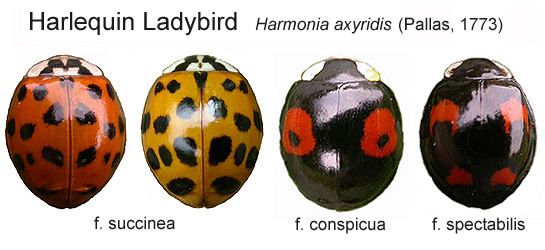

| The effects of the Harlequin Ladybird in Nottinghamshire | ||
| Along with many other naturalists, newspaper columnists and website owners, we wrote a great deal on the invasive Harlequin Ladybird and it's arrival in Nottinghamshire almost a decade ago. | ||
| ... | ||
| The Harlequin Ladybird (Harmonia axyridis) first appeared in the UK in 2004. Soon
after it's arrival, it was exceptionally quick to
colonise new areas of the country, whilst substantially
strengthening its existing populations in the south-east.
Within the space of a couple of years, it had reached the north-west of England and the Welsh borders. |
 |
|
| ... | ||
| Nottinghamshire's
first acceptable record was from Eakring in July 2006,
although there is little doubt that it had already become
well established in parts of Nottinghamshire as early as
late 2005. One was claimed from Wollaton at the time, but
the record could not be accepted by the county recorder,
on the basis of lack of photographic evidence or
specimen. The Eakring record initially seemed to be an isolated one, but a few weeks later, we eventually discovered numbers of Harlequin Ladybirds at Hare Hill Wood near Kersall and in early November we counted 151 adults. By January 2007, most of the Harlequins at Hare Hill Wood had disappeared, but we did find a small over-wintering group under loose bark and in company with a number of 2-spot Ladybirds. Along with literally hundreds of other invertebrates, the 2-spot Ladybird was just one of many species of Ladybird deemed threatened following the Harlequin's UK arrival. Native Ladybirds at risk We have made regular counts since 2006, so we thought that it might be time to look at our Ladybird records further, to see if there has been any sign of the predicted dramatic decline in the numbers of our native Ladybirds. The species we thought to be most at risk ,would be the 2, 7, 10 and 14-spot, Orange, Cream-spot and Pine Ladybirds. We've classed these Ladybirds most at risk, because they often share a preference for Lime, Beech and Sycamore trees, which the Harlequin often favours. In urban areas, Lime and Sycamore trees used in urban street-planting schemes for years, are particularly attractive to Ladybirds, as they are more prone to developing large accumulations of Aphids, more than most other trees. As our records date back to when the Harlequin first arrived in Nottinghamshire, we have looked at the total number of individuals of each species recorded since then and have included our latest records for 2014. The graph below shows our annual Ladybird counts dating from 2006 to 2014. We have not included the data for both Harlequin and 7-spot Ladybirds in this graph, as the pure size of their counts in some years, renders the smaller counts of the other six species almost invisible. |
||
| ... | ||
 |
||
| ... |
| ... | |||||||||||||||||||||||||||||||||||||||||||||||||||||||||||||||||||||||||||||||||||||||||||||||||||||||||||||||||||||||||||||||||||||||||||||||||||||||||||
|
It must be remembered
that we are only concerned with Nottinghamshire here, so
the picture from other parts of the UK may well be
different, although we believe unlikely. The after
effects of the Harlequin's arrival, may also be more
evident in urban areas, something which could make a very
useful study in schools? Table 01 shows the fortunes of the eight species selected. The figures in the GLr column, are the annual counts, of which anything above would represent a good year. For example - a total annual count of above 60, would class the 2-spot Ladybird as having had a good year. |
||||||||||||||||||||||||||||||||||||||||||||||||||||||||||||||||||||||||||||||||||||||||||||||||||||||||||||||||||||||||||||||||||||||||||||||||||||||||||
| ... | |||||||||||||||||||||||||||||||||||||||||||||||||||||||||||||||||||||||||||||||||||||||||||||||||||||||||||||||||||||||||||||||||||||||||||||||||||||||||||
| Our records show that the likely affected species, either have mostly low population levels anyway, or are predominantly arboreal and less likely to be seen, but will occur in higher numbers when favourable conditions arise. Weather/climatic conditions at certain times of the year, will be one determining factor to the fortunes of all species. We consider changes to habitat or habitat loss, to be a less likely factor for our selected species, as all frequently occur in urban areas and are not habitat specific. | |||||||||||||||||||||||||||||||||||||||||||||||||||||||||||||||||||||||||||||||||||||||||||||||||||||||||||||||||||||||||||||||||||||||||||||||||||||||||||
| ... | |||||||||||||||||||||||||||||||||||||||||||||||||||||||||||||||||||||||||||||||||||||||||||||||||||||||||||||||||||||||||||||||||||||||||||||||||||||||||||||||||||||||
|
Table 02 shows our
Ladybird counts for each year since 2006. The two rows in blue, show the combined totals of all species (Totals 1) with the same totals, minus those of the 7-spot and Harlequin in Totals 2. We have never recorded either Orange or Cream-spot Ladybirds in any real numbers and our records consist of single individuals (or very rarely) small groups. Both have proved to have low population levels based on our records. The Pine Ladybird is another species, more usually found in small numbers, but it does occasionally have years of abundance. |
||||||||||||||||||||||||||||||||||||||||||||||||||||||||||||||||||||||||||||||||||||||||||||||||||||||||||||||||||||||||||||||||||||||||||||||||||||||||||||||||||||||
| ... | |||||||||||||||||||||||||||||||||||||||||||||||||||||||||||||||||||||||||||||||||||||||||||||||||||||||||||||||||||||||||||||||||||||||||||||||||||||||||||||||||||||||